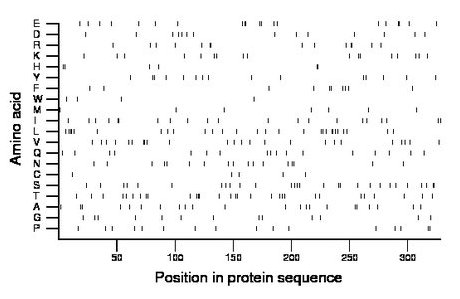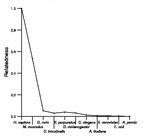
| Name: CD84 | Sequence: fasta or formatted (328aa) | NCBI GI: 4502687 | |
|
Description: CD84 molecule
|
Referenced in: Hematopoiesis and Erythrocytes
| ||
|
Composition:

Amino acid Percentage Count Longest homopolymer A alanine 6.7 22 2 C cysteine 1.5 5 1 D aspartate 4.3 14 1 E glutamate 6.1 20 2 F phenylalanine 3.0 10 2 G glycine 4.0 13 1 H histidine 1.8 6 2 I isoleucine 6.4 21 2 K lysine 5.2 17 2 L leucine 8.5 28 3 M methionine 2.1 7 1 N asparagine 5.2 17 2 P proline 4.9 16 2 Q glutamine 5.2 17 1 R arginine 4.3 14 2 S serine 8.5 28 2 T threonine 9.1 30 3 V valine 7.3 24 2 W tryptophan 1.2 4 1 Y tyrosine 4.6 15 2 |
Comparative genomics:
Search single species RefSeq proteins at NCBI
Search summary 
Figure data | ||
Related human proteins:Protein Relative score Description Self-match 1.000 CD84 molecule SLAMF9 0.184 SLAM family member 9 isoform 1 LY9 0.182 lymphocyte antigen 9 isoform a SLAMF7 0.172 SLAM family member 7 SLAMF6 0.169 activating NK receptor precursor SLAMF9 0.076 SLAM family member 9 isoform 2 CD244 0.076 CD244 natural killer cell receptor 2B4 LY9 0.076 lymphocyte antigen 9 isoform b HEPACAM 0.068 hepatocyte cell adhesion molecule SLAMF1 0.059 signaling lymphocytic activation molecule family memb... SLAMF8 0.055 SLAM family member 8 NEGR1 0.044 neuronal growth regulator 1 HEPACAM2 0.038 HEPACAM family member 2 isoform 2 HEPACAM2 0.038 HEPACAM family member 2 isoform 1 IGLON5 0.038 IgLON family member 5 CEACAM5 0.035 carcinoembryonic antigen-related cell adhesion molec... LSAMP 0.033 limbic system-associated membrane protein CEACAM1 0.030 carcinoembryonic antigen-related cell adhesion molec... CEACAM1 0.030 carcinoembryonic antigen-related cell adhesion molec... PSG7 0.027 pregnancy specific beta-1-glycoprotein 7 precursor ... CD2 0.024 CD2 molecule CEACAM21 0.022 carcinoembryonic antigen-related cell adhesion mole... CD48 0.022 CD48 molecule SLAMF9 0.022 SLAM family member 9 isoform 3 PSG8 0.021 pregnancy specific beta-1-glycoprotein 8 isoform b ... PSG8 0.021 pregnancy specific beta-1-glycoprotein 8 isoform a [... VSIG2 0.021 V-set and immunoglobulin domain containing 2 PSG3 0.021 pregnancy specific beta-1-glycoprotein 3 CEACAM20 0.021 carcinoembryonic antigen-related cell adhesion mole... CEACAM21 0.021 carcinoembryonic antigen-related cell adhesion molec...Human BLASTP results (used to prepare the table) | |||
Gene descriptions are from NCBI RefSeq. Search results were obtained with NCBI BLAST and RefSeq entries. When identical proteins are present, the self-match may not be listed first in BLASTP output. In such cases, the table above has been reordered to place it first.
See About the Figures for the scoring system used in the figure above right. The same scoring system was used in the table of BLASTP results.
Guide to the Human Genome
Copyright © 2010 by Stewart Scherer. All rights reserved.
